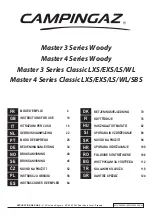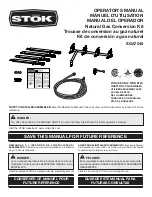
GB
To avoid flare ups while grilling fatty food, cook at reduced
temperature, switching off one or more burners if necessary.
Clean the barbecue after each use to prevent the accumulation
of grease and flare ups.
Depending on the models, your barbecue may be equipped
with a cast iron cooking plate. This plate has a double cooking
face: one ribbed face permitting the searing of meats and one
smooth face for fish, shellfish, vegetables, etc…
Depending on model, your barbecue can be equipped with a
Searing Boost Station (SBS).
In this case, to sear your piece of meat:
y
Turn on the 3 burners of the SBS zone.
y
Put your piece of meat on the cooking grid in the zone
identified as SBS.
y
Sear the first face of the piece (time at your convenience and
depending on the size of the piece).
y
Do the same for the second face.
You can then shut off the central burner of the SBS zone to
cook the heart of the meat.
Important: If one or several burners go out whilst you
are using the appliance, turn the control knobs to OFF
immediately (O). Wait five minutes to allow the unburned gas
to escape. Only carry out the lighting steps after this time.
P. CLEANING AND MAINTENANCE
Never modify the appliance: any modification may prove
dangerous.
y
In order to maintain your appliance in perfect operating
condition, it is recommended to clean it periodically (after
4 or 5 uses).
y
Wait until the appliance has cooled down before cleaning.
y
Close the gas cylinder and remove the regulator.
y
(Fig. 9) Clean the top of the burner, as well as the sides and
base, using a moist sponge (water with dish washing liquid).
If necessary, use a damp steel brush.
y
(Fig. 9) Check that all burner outlets (OH) are clear and dry
before using again. If necessary, use a wire brush to unclog
the burner outlets.
y
(Fig. 9) Clean the orifices on the Venturi (VO) or the burner
if necessary.
y
The grill burner must be cleaned and checked every 3
months. Remove the entire burner (Fig. 9) and check that
no dirt or spider webs are blocking the venturi tube openings
(Fig. 4), which may cause the burner to be less efficient or
cause a dangerous gas fire outside the burner.
Refit the grill burner correctly.
NOTE:
Regular cleaning extends the lifetime of the burner and
prevents premature oxidation that may result from cooking
acid residue. Oxidation of the grill burner is, however, normal.
Control panel
Clean the control panel from time to time using a sponge
damped with dish washing liquid. Do not use abrasive
products.
Firebox wall
To facilitate the cleaning of the firebox wall, Campingaz
®
has invented
Campingaz InstaClean
®
, the concept of the
removable firebox. Thanks to
Campingaz InstaClean
®
, all the
parts of the firebox are removable in under one minute without
a need for a tool. These parts are dishwasher safe.
Depending on the degree of dirtiness of these parts, it may
be necessary to brush the parts before putting them into the
dishwasher for a more complete cleaning.
For the assembly and removal of these parts, refer to the
assembly manual.
For reassembly after cleaning, put in the two walls numbered
“1-2” first, and then the walls numbered “2-3”, and finally the
two side walls numbered “3-1” (Fig. 11).
Grease collection tray
Depending on the model, your barbecue may be equipped
with one or two grease collection trays. It is recommended that
you clean it (them) after each use. It (they) can be washed in
the dishwasher.
For ease of cleaning, you may cover the grease tray(s) with
disposable aluminum foil. After use of the barbecue, discard
the aluminium foil.
To easily absorb cooking grease, you may spread a handful of
sand onto the bottom of the grease collection tray. Discard the
sand after each use.
Griddle and grid
The griddle and grid are enamelled.
Wait for them to cool before any cleaning operation. Use
a Campingaz
®
BBQ Cleaner Spray cleaning product and
brushes for barbecues.
You may clean your griddle and grid in the dishwasher. Before
putting them into the dishwasher, it is often necessary to
scrape them with a sponge or a metallic brush to remove
residue that sticks to the cooking surface.
(Fig. 12) To remove the griddle and grid, slide your finger into
the indicated holes, lift them and take hold of them with the
other hand.
(Fig. 13) To remove the
Campingaz
®
Culinary Modular
grid
that is made up of 2 parts (see section
§ R. Accessories
below), first remove the central part with the help of the
indicated tab, and then remove the contour.
The cast iron cooking surfaces are porcelain enamelled which
protects the cooking surface material from corrosion. Cast iron
cooking surfaces can come in either a shiny and glossy look or
in a thinner textured matt appearance. To keep them in pristine
condition, it is important to oil matt cast iron surfaces after
cleaning. Grilled foods don’t stick as easily to the surface which
aids cleaning and extends the lifetime of the cooking surface.
Wood
(depending on the model):
For protection and the maintenance of natural appearance,
the wood on your barbecue is covered with protective oil. It is
however a living material which remains sensitive to exposure
to the sun ray, humidity and changes in temperature.
Stainless Steel:
Stainless steel is known for its ability to resist corrosion and
rust. However, dirt, dust, grime and non-appropriate cleaners
put stainless steel at risk for corrosion and rust. Stainless steel
responds well to cleaning as long as certain rules are followed
DO :
y
Read carefully the instructions on the cleaning products
and make sure it’s appropriate for stainless steel.
Ideally, use specific stainless steel cleaners. Pay special
attention to some of them which can be inappropriate for
paints, these look like aluminum or stainless steel and
can erase markings.
y
Use a safe, non-abrasive sponge. Brush in the direction
of the grain of the metal.
y
Rinse thoroughly.
y
Always dry the surface with a soft towel or cloth. A
microfibre towel is preferable.
DON’T :
y
Never leave wet sponges, cloths, or cleaning pads on the
Stainless steel surface.
y
Never leave solutions of chlorine bleach and water on
your Stainless steel surface. Chlorides, which are found
in most soaps, detergents, bleaches, and cleansers, are
12













































